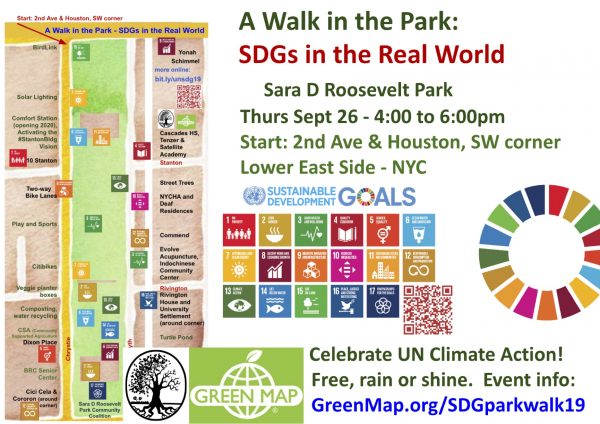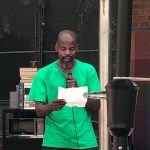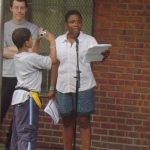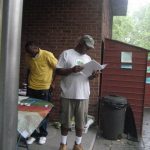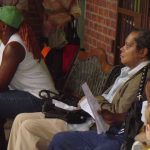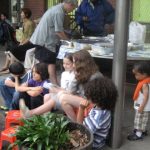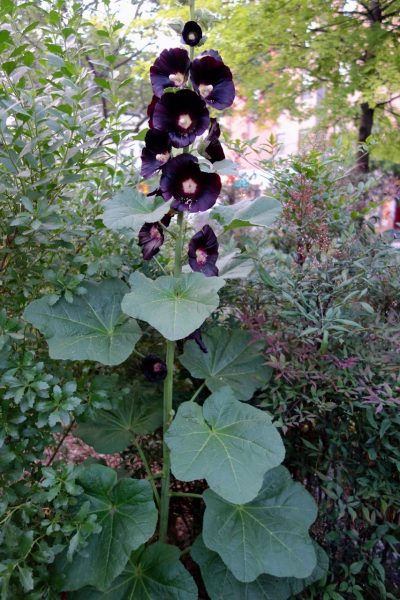“Green Map 2020: Evolving with Technology and Staying Community Focused”
From:
eSpatially New York
“Perspectives on the Geospatial Community in the Empire State”
“For nearly 30 years, Green Map has been an anchor in the Metro NYC nonprofit mapping community. Led by its original founder, Wendy Brawer, Green Map’s portfolio of work and advocacy in locally-led mapping and sustainability efforts is quite impressive. Since the launch of the Green Map System by Wendy Brawer in 1995 and publication of the original Green Map of NYC through her eco-design company, the program’s engagement tools and mapping resources have been adapted by locally-led projects in 65 countries…”
“…Last September, the Sara D. Roosevelt Park Coalition partnered with Green Map during the UN Climate Summit to connect local and long standing grassroots community sustainable efforts with the work of the United Nation’s (UN) Sustainable Development Goals (SDG).”
Read more here
From University Settlement Virtual Book Talk
|
Rescue of a Fallen Cypress Tree in Sara Roosevelt Park
Thank you To Elizabeth, Peter, Jonathan and Alexander!
“It has a teeny tiny root ball, and I think the hard soil is the source of the problem. Tomorrow we will change it and stabilize it.” Elizabeth
Elizabeth wrote (M’Finda Kalunga Gardener and Bird Savior):
“It will take at least 3 people, and the task is to lift up the fallen cypress tree on the SW corner of Delancey and Forsyth. It had fallen some years and go and was slowly being propped back up to straight, but recent weather dismantled its rope and it now has its roots out of the ground.”
“I think that I shall never see a poem as lovely as a tree” Joyce Kilmer
************************
Important Parks Department Service Changes Due to the Coronavirus (COVID-19)
Updated: Monday, June 22 at 6:00 a.m.
The World Health Organization has declared the COVID-19 disease, known as the coronavirus, a pandemic. During this time, we ask that all park goers use additional precautions to protect their health and safety and that of those around them.
At this time, City parks are open. We ask that all park goers take extra precautions to stay healthy and safe. While solo exercise is okay, team sports (such as basketball, football, softball, and soccer) are not permitted in our parks at this time. Please maintain at least 6 feet of distance between yourself and others when outside and avoid congregating in groups.
Our park restrooms are open. We are cleaning our restrooms daily with appropriate cleaning products to ensure that they are being fully disinfected. Restrooms located within City playgrounds are closed until further notice.
Our city playgrounds are open. For public safety, please wear a face covering and maintain at least six feet of distance between each child not in the same household. Playgrounds are cleaned daily, however, play equipment is not sterilized. Please stay home if you or your child feels sick, and wash your hands frequently, including before and after using play equipment.
For more information about coronavirus and a guide on how to stay safe, please visit http://nyc.gov/coronavirus , or text COVID to 692-692 to receive regular SMS texts with the latest news and developments from Notify NYC .
Service Changes and Cancellations
Many events being held in parks by outside groups are being canceled or rescheduled. Before attending, please check with the organizing group to confirm.
COVID-19 Testing
Free COVID-19 testing is now available in New York City at more than 100 locations across the city. Visit the City’s COVID-19 Testing page for more.
Face Coverings
New York City will continue face coverings in parks across the city free of charge through the social distancing period. For more information visit nyc.gov/facecoverings .
Facility Re-Openings
As our facilities re-open, we ask that patrons wear a face covering and maintain at least six feet of social distance between each household. Wash your hands frequently and wipe down equipment. Cover your coughs and sneezes, do not touch your face, and stay home if you feel sick.
- City playgrounds began opening as of June 22.
- Golf courses and driving ranges are re-open as of June 22.
Facility Closures
- All NYC Parks Recreation Centers are closed to the public until further notice. We will be extending all memberships to our recreation center members to cover the length of time we are closed.
- City beaches are closed for swimming until further notice. Walking, running, exercising, and access to the sand and boardwalk are still permitted during regular park hours.
- Spray showers are closed.
- Barbecuing and gatherings are prohibited and grilling areas are closed.
- Basketball, handball, and tennis courts are closed and locked. All basketball court rims and tennis nets have been removed.
- Bocce courts and volleyball courts are closed.
- Dog runs are closed until further notice. Our parks remain open to dogs and pet owners to get fresh air and exercise. Our off-leash rules still apply, but please note that the Center for Disease Control recommends that all dog owners keep their dogs on a leash and maintain at least six feet of distance from other people and animals.
- All City nature centers are closed until further notice.
- The City’s historic houses are closed.
- Roger Morris Park, Dyckman Farmhouse Park, and Queens Farm Park are closed.
- The Swedish Cottage is closed.
- As a precaution, the High Line is closed.
- To provide a staging area for first responders, Fort Totten Park is closed to the public through June 1.
- The Arsenal Gallery is closed until further notice.
- At this time, many concessions are closed, including amusement parks and carousels, golf courses, indoor tennis facilities, souvenir shops, and more.
- Farmers markets and gas stations remain open. Customers must practice social distancing.
- Most bicycle rental operations are open. Customers must practice social distancing.
- Some snack bars & restaurants remain open for takeout or delivery. Customers must practice social distancing.
- For the health and safety of the horses, stables will remain operational, but closed to the general public. Sunrise Stables is open as of Monday, June 8.
Programming Cancellations
In response to the State and City’s directive, all public gatherings in our parks are cancelled through June 30. In the interest of the health and safety of all of our patrons, NYC Parks is not accepting, nor reviewing, event applications for any Special Events until further notice.
Field and Court applications for the fall 2020 season (September 1 – November 30) are now available and must be submitted by July 31. We will not process applications or charge any fees for the fall until we are given the directive that it is safe to re-open fields for permitted play. Team sports are not allowed at this time.
- All Shape Up NYC programs are cancelled until further notice. Please follow Shape Up NYC on Facebook for news on upcoming free online fitness opportunities.
- Adventures NYC is cancelled.
- Urban Park Ranger programs are cancelled.
- All tournaments and sports practices are cancelled.
- All special events held in recreation centers have been cancelled.
- NYC Parks Stewardship events have been postponed until further notice.
Programming Service Changes
- NYC’s tennis season is delayed until further notice. Tennis permit sales have been suspended for the 2020 season. If you have already purchased a tennis permit, it will be valid through 2021.
- GreenThumb community gardens are closed to the general public until further notice. Gardens are open to garden members only at the discretion of each group, and only for absolutely necessary maintenance and season preparation.
- Marinas, boatyards, and boat launches are open for personal use of vessels only. Vessel charters, rentals, and group activities or social gatherings are prohibited. Patrons must practice social distancing at all times and wear a face covering where social distancing is not possible.
Juneteenth 2005 -2019 in M’Finda Kalunga Community Garden
One woman’s decision and Juneteenth happened every year since 2005 in M’Finda Kalunga Community Garden.
This year, she’s going to enjoy it without the work. And that just might be progress…
Thank you Debra Jeffreys-Glass for everything.
- Go to the previous page
- 1
- …
- 39
- 40
- 41
- 42
- 43
- 44
- 45
- …
- 164
- Go to the next page










